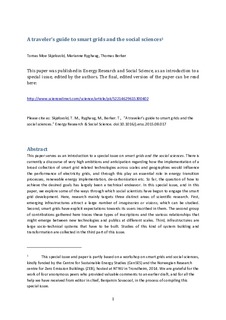| dc.contributor.author | Skjølsvold, Tomas Moe | |
| dc.contributor.author | Ryghaug, Marianne | |
| dc.contributor.author | Berker, Thomas | |
| dc.date.accessioned | 2017-10-31T09:27:52Z | |
| dc.date.available | 2017-10-31T09:27:52Z | |
| dc.date.created | 2015-09-04T20:26:41Z | |
| dc.date.issued | 2015 | |
| dc.identifier.citation | Energy Research & Social Science. 2015, 9 1-8. | nb_NO |
| dc.identifier.issn | 2214-6296 | |
| dc.identifier.uri | http://hdl.handle.net/11250/2463096 | |
| dc.description.abstract | This paper serves as an introduction to a special issue on smart grids and the social sciences. There is currently a discourse of very high ambitions and anticipation regarding how the implementation of a broad collection of smart grid related technologies across scales and geographies would influence the performance of electricity grids, and through this play an essential role in energy transition processes, renewable energy implementation, de-carbonization etc. So far, the question of how to achieve the desired goals has largely been a technical endeavor. In this special issue, and in this paper, we explore some of the ways through which social scientists have begun to engage the smart grid development. Here, research mainly targets three distinct areas of scientific research. First, emerging infrastructures attract a large number of imaginaries or visions, which can be studied. Second, smart grids have explicit expectations towards its users inscribed in them. The second group of contributions gathered here traces these types of inscriptions and the various relationships that might emerge between new technologies and publics at different scales. Third, infrastructures are large socio-technical systems that have to be built. Studies of this kind of system building and transformation are collected in the third part of this issue. | nb_NO |
| dc.language.iso | eng | nb_NO |
| dc.publisher | Elsevier | nb_NO |
| dc.rights | Attribution-NonCommercial-NoDerivatives 4.0 Internasjonal | * |
| dc.rights.uri | http://creativecommons.org/licenses/by-nc-nd/4.0/deed.no | * |
| dc.title | A traveler’s guide to smart grids and the social sciences | nb_NO |
| dc.type | Journal article | nb_NO |
| dc.type | Peer reviewed | nb_NO |
| dc.description.version | acceptedVersion | nb_NO |
| dc.source.pagenumber | 1-8 | nb_NO |
| dc.source.volume | 9 | nb_NO |
| dc.source.journal | Energy Research & Social Science | nb_NO |
| dc.identifier.doi | 10.1016/j.erss.2015.08.017 | |
| dc.identifier.cristin | 1262133 | |
| dc.relation.project | Norges forskningsråd: 209697 | nb_NO |
| dc.relation.project | Norges forskningsråd: 220500 | nb_NO |
| dc.description.localcode | © 2015. This is the authors’ accepted and refereed manuscript to the article. This manuscript version is made available under the CC-BY-NC-ND 4.0 license http://creativecommons.org/licenses/by-nc-nd/4.0/ | nb_NO |
| cristin.unitcode | 194,62,40,0 | |
| cristin.unitname | Institutt for tverrfaglige kulturstudier | |
| cristin.ispublished | true | |
| cristin.fulltext | postprint | |
| cristin.qualitycode | 1 | |

